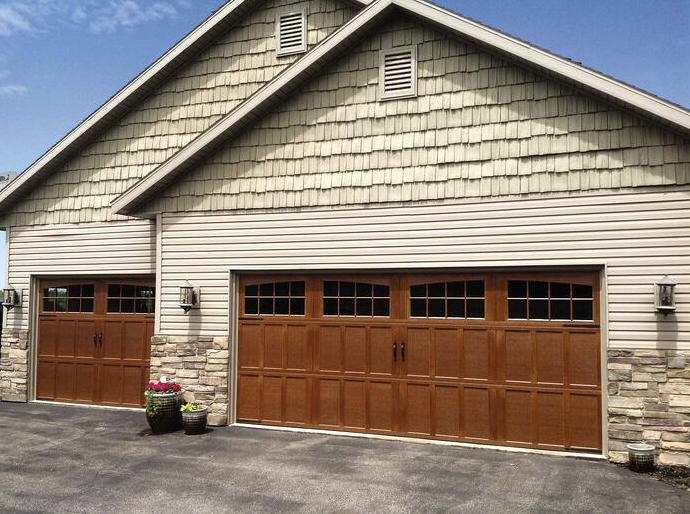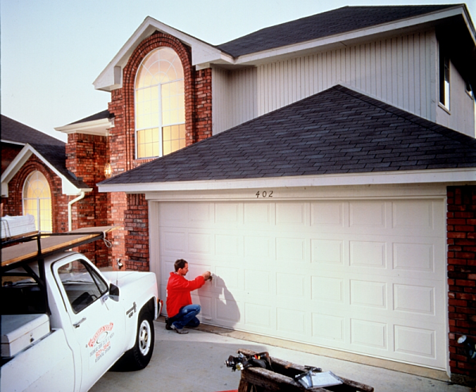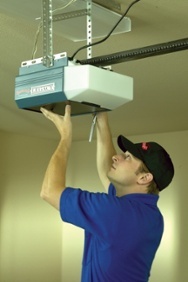Properly maintaining your garage door can save you money while protecting the convenience and overall functionality of your door. Simple maintenance tasks are attainable for the average homeowner, while major repairs and part replacement should be left to the experts. Keeping up with your garage door saves you money while also boosting the longevity and safety of your door. The following tips will set you up for success and extend the life of your garage door.
-
 Check the
appearance of your garage door.
If the door is made of wood, check for water damage or areas
where the paint is peeling. Water damage will require immediate repair. If your
garage door is steel, look for rust spots that need to be sanded, primed and
painted. After any repairs are made, clean your door with the appropriate
cleaner and allow the door to dry.
Check the
appearance of your garage door.
If the door is made of wood, check for water damage or areas
where the paint is peeling. Water damage will require immediate repair. If your
garage door is steel, look for rust spots that need to be sanded, primed and
painted. After any repairs are made, clean your door with the appropriate
cleaner and allow the door to dry. - Apply lubricant to all moving parts. Lubricating the moving parts on your
garage door greatly impacts the lifespan of your door. To help limit the stress
on your door, keep rollers, hinges and the spring system well lubricated, but
avoid the tracks. Be sure to use the proper lubricant and clean off any excess
after you’re done. The
best garage door lubricant should be lithium based to keep it
operating smoothly and quietly.
-
Check the tracks
for debris and rust.
Using
a damp cloth or a solvent metal cleaner, make sure your tracks are free of dirt
and dust. This prevents premature failure of your rollers, springs and
bearings.
 Inspect your weatherstripping. You may need to replace or repair the weatherstripping around the bottom of your door and
the garage opening. These strips help you save money and energy by keeping out
the cold, water, dust and dirt. If your weatherstripping is damaged or torn we
suggest having it replaced.
Inspect your weatherstripping. You may need to replace or repair the weatherstripping around the bottom of your door and
the garage opening. These strips help you save money and energy by keeping out
the cold, water, dust and dirt. If your weatherstripping is damaged or torn we
suggest having it replaced. - Test your garage door safety
features.
All garage
door openers have auto-reverse features to make sure you and your family stay
safe. You can perform a series of tests to check the reaction of the door. Test
the auto-reverse safety feature by placing a 2x4 board on the ground under the
garage door. When the door comes down on the board it should reverse directions
and open back up. For more detailed instructions on the reversal test,
visit this post, “How to Test that
your Garage Door Reverses Properly”.
- Test the door balance. Making sure your garage door is
balanced is crucial for the safety and lifespan of your door and opener.
Regularly inspect the balance by pulling the release handle when the door is in
a down position to put the garage door in manual mode. Push the door up until
it is halfway open, if the door remains in place it is properly balanced.
However, if the door starts to raise or drop it is improperly balanced and the
springs may be starting to wear out. If you are not able to lift the door, you
may have a broken spring. In both cases, contact your local
Overhead Door ® distributor to have a professional service your
door.
-
 Make sure hardware
is tight.
Due to the
frequent use and vibrations that come with opening and closing your garage
door, hardware can start to loosen over time. Check all track brackets and door
fasteners to make sure the bolts are tight.
Make sure hardware
is tight.
Due to the
frequent use and vibrations that come with opening and closing your garage
door, hardware can start to loosen over time. Check all track brackets and door
fasteners to make sure the bolts are tight.
- Inspect rollers, cables and door springs. Any damaged or cracked rollers need to be replaced and well lubricated. Damaged or worn springs and cables should also be replaced by a professional, the tension in the springs is dangerous and should never be adjusted by a homeowner.
Performing periodic at home inspections will save you money and help you spot a problem, extending the life of your garage door. If you need to replace a part to properly maintain your door, shop garage door parts with Overhead Door Parts Online. You can also find more safety, security and maintenance information by checking out these tips from Overhead Door Company of Northern Kentucky ™.

